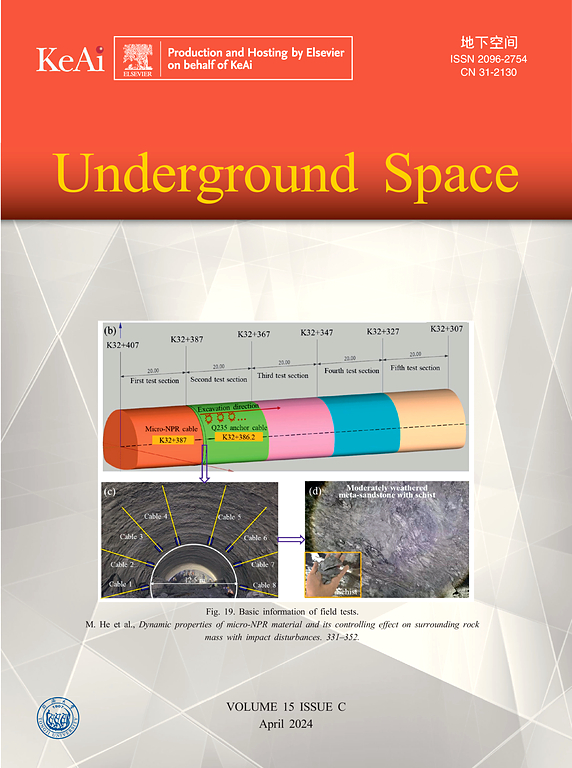Cutting-edge approaches to specific energy prediction in TBM disc cutters: Integrating COSSA-RF model with three interpretative techniques
IF 8.3
1区 工程技术
Q1 ENGINEERING, CIVIL
引用次数: 0
Abstract
Specific energy (SE) is an important index to measure crushing efficiency in mechanized tunnel excavation. Accurate prediction of the SE of tunnel boring machine disc cutters is important for optimizing the crushing process, reducing energy consumption, and minimizing machine wear. Therefore, in this paper, the sparrow search algorithm (SSA), combined with six chaotic mapping strategies, is utilized to optimize the random forest (RF) model for predicting SE, referred to as the COSSA-RF prediction models. For this purpose, an SE prediction database was established for training and validating model performance, encompassing 160 sets of experimental data, each with six input parameters: uniaxial compressive strength (UCS), Brazilian tensile strength (BTS), disc cutter diameter (D), cutter tip width (T), cutter spacing (S), and cutter penetration depth (P), along with a target parameter, SE. The evaluation results indicate that the COSSA-RF models demonstrate superior performance compared to other four machine learning models. In particular, the Chebyshev map-SSA-RF (CHSSA-RF) model achieves the most satisfactory prediction accuracy among all models, resulting in the highest coefficient of determination R2 and dynamic variance-weighted global performance indicator values (0.9756 and 0.0814) and the lowest values of root mean square error (RMSE), mean absolute error (MAE), and mean absolute percentage error (MAPE) (6.4742, 4.0003, and 20.41%). Lastly, the results of interpretability analysis of the best model through SHapley Additive exPlanations, local interpretable model-agnostic explanations, and Vivid methods show that the importance of input parameters ranked as follows: UCS, BTS, P, S, T, and D. Moreover, interactions between parameters (UCS and BTS, BTS and P, and BTS and S) significantly influence the model predictions.
TBM盘式铣刀比能预测的前沿方法:将COSSA-RF模型与三种解释技术相结合
比能(SE)是衡量机械化隧道开挖破碎效率的重要指标。准确预测隧道掘进机盘式铣刀的切削效率对优化破碎工艺、降低能耗、减少机器磨损具有重要意义。因此,本文利用麻雀搜索算法(SSA),结合6种混沌映射策略,对预测SE的随机森林(RF)模型进行优化,简称COSSA-RF预测模型。为此,我们建立了一个SE预测数据库,用于训练和验证模型的性能,该数据库包含160组实验数据,每组数据有6个输入参数:单轴抗压强度(UCS)、巴西抗拉强度(BTS)、盘式刀具直径(D)、刀具尖端宽度(T)、刀具间距(S)和刀具穿透深度(P),以及目标参数SE。评估结果表明,与其他四种机器学习模型相比,COSSA-RF模型表现出优越的性能。其中,Chebyshev map-SSA-RF (CHSSA-RF)模型的预测精度在所有模型中最令人满意,其决定系数R2和动态方差加权全局性能指标值最高(0.9756和0.0814),均方根误差(RMSE)、平均绝对误差(MAE)和平均绝对百分比误差(MAPE)最低(6.4742、4.0003和20.41%)。最后,通过SHapley加性解释、局部可解释模型不可知解释和Vivid方法对最佳模型的可解释性分析结果表明,输入参数的重要性依次为:UCS、BTS、P、S、T和d,参数之间的交互作用(UCS与BTS、BTS与P、BTS与S)显著影响模型预测。
本文章由计算机程序翻译,如有差异,请以英文原文为准。
求助全文
约1分钟内获得全文
求助全文
来源期刊

Underground Space
ENGINEERING, CIVIL-
CiteScore
10.20
自引率
14.10%
发文量
71
审稿时长
63 days
期刊介绍:
Underground Space is an open access international journal without article processing charges (APC) committed to serving as a scientific forum for researchers and practitioners in the field of underground engineering. The journal welcomes manuscripts that deal with original theories, methods, technologies, and important applications throughout the life-cycle of underground projects, including planning, design, operation and maintenance, disaster prevention, and demolition. The journal is particularly interested in manuscripts related to the latest development of smart underground engineering from the perspectives of resilience, resources saving, environmental friendliness, humanity, and artificial intelligence. The manuscripts are expected to have significant innovation and potential impact in the field of underground engineering, and should have clear association with or application in underground projects.
 求助内容:
求助内容: 应助结果提醒方式:
应助结果提醒方式:


